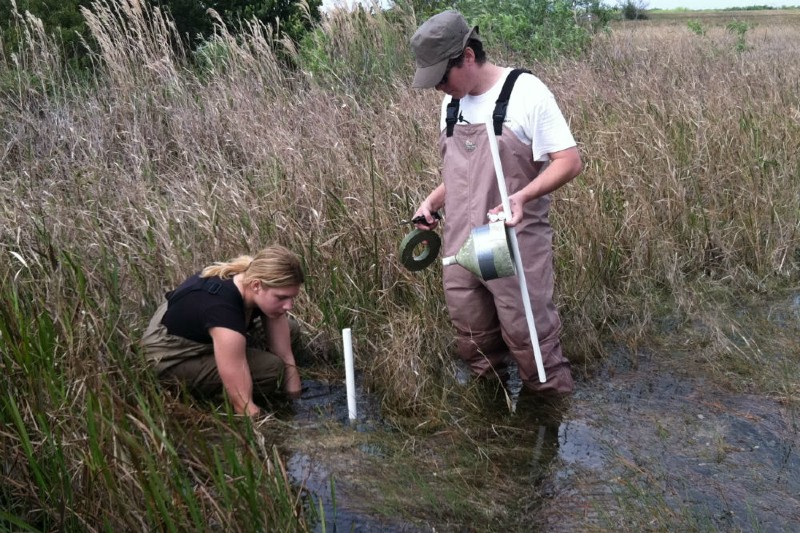Our researchers have spent more than three decades guiding management, restoration and protection of water resources in and around the Everglades: one of the largest environmental restoration projects on the planet.
30+
Years working on research in the Florida Everglades
102
Faculty, staff and students working on Everglades research with the Institute of Environment
66
ForEverglades & Cristina Menendez Scholars since 2008
Our Impacts
More than 8 million South Floridians rely on the Florida Everglades for their drinking water, and the ability to have a thriving economy hinges on an abundant supply of freshwater. We must protect the Florida Everglades. For more than 30 years, FIU researchers have collaborated on and led the science behind Everglades restoration — one of the largest environmental projects on the planet. We are one of only three universities selected by the South Florida Water Management District to collaborate on a $4.1 million Everglades restoration project.
You can learn more about our most recent efforts through the Florida Coastal Everglades Long Term Ecological Research Program or the NSF CREST Center for Aquatic Chemistry and Environment.
If you are an undergraduate student interested in participating in Everglades research during summertime, please visit our Coastal Ecosystems Research Experience for Undergraduates (REU).
The Future of Everglades Restoration
The Institute awards FIU graduate students working in the Everglades with our annual Cristina Menendez Memorial Fellowship. Find out more about the Cristina Menendez Memorial Fellowship.
Our Institute of Environment and The Everglades Foundation award scholarships each year to student researchers working in the Everglades. Find out more about the FIU ForEverglades Scholarship.
Everglades Scholars and Fellows
The Cristina Menendez Memorial Fellowship was created in memory of former student Cristina Menendez to provide graduate students with support for Everglades-related research projects that will help to protect and restore the unique Florida Everglades ecosystem.
The 2021 recipients are:
- Kenneth Anderson – Breakdown and microbial priming of particulate organic matter in coastal wetlands
- Cody Eggenberger – Southeast United States Cross-Site Comparison of Juvenile Atlantic Tarpon Trophic Dynamics
- Paige Kleindl – Macrophyte and Microbial Mat Competition for Limiting Nutrients within the Florida Everglades
- Steven Landeweer – Occurrence, fate and transport of UV filter compounds in the Greater Everglades Ecosystem
- Xuerong Li – Assessment of the occurrence and distribution of poly- and perfluoroalkyl substances (PFAS) in surface waters from Everglades
- Joshua Linenfelser – Monitoring water quality using stable isotope biochemistry in the estuarine zone where Taylor Slough meets with the Florida Bay environment: Algal communities
- Brian Ng – Non-target Analysis Using High Resolution Mass Spectrometry to Characterize and Remediate Urban Waters: From the Everglades to Biscayne Bay
- Ikechukwu Onwuka – Minimizing phosphorous loads from increased freshwater deliveries to the Everglades
- Jonathan Rodemann – Effects of shifting seascapes, salinity gradients, and hypersalinity on the movement and habitat use of Spotted Seatrout (Cynoscion nebulosus) in Florida Bay
- Thomas Shannon – Responses of Benthic Diatom Assemblages following Simulated Saltwater and Phosphorus Groundwater Intrusions, in Southeastern FL Everglades
- Katie Stansbury – Drivers of extracellular polysaccharide production by a mat-forming diatom
- Kassidy Troxell – Detecting and Identifying Water Contaminants Unique to Specific Sources in the Environment: assessing provenance
- Rosario Vidales – Red mangrove (Rhizophora mangle L.) leaf nitrogen, phosphorus and secondary metabolites in face of nutrient inputs and salinity influence during early stages of Everglades rehydration projects
Meet the 2021 Cristina Menendez Memorial Fellows.
Ongoing Research
Experts on the Everglades
FIU researchers work in all parts of the Everglades and with partners in government, nonprofit organizations and businesses.
Media seeking interviews should contact Ayleen Barbel or Chrystian Tejedor or browse featured experts.

Deepening our knowledge of Everglades species and ecosystem interactions

Florida Coastal Everglades LTER
Monitoring effects of climate change, disturbances and resource management

CREST Center for Aquatic Chemistry and Environment
Seeking to understand and combat environmental contamination
Support Our Work
Your support allows us to provide the science needed for improved policy and management decisions, helping to ensure a future for the Florida Everglades and other ecosystems.